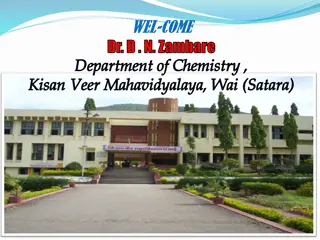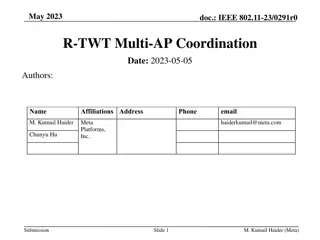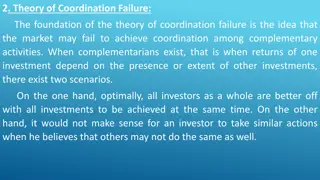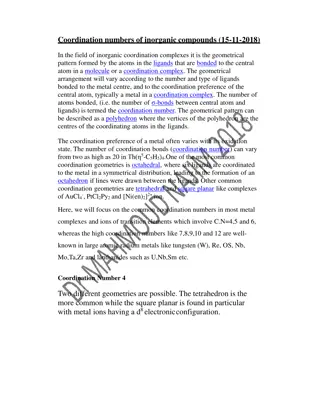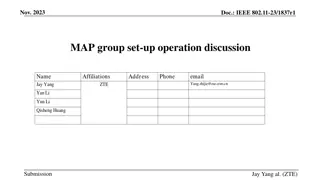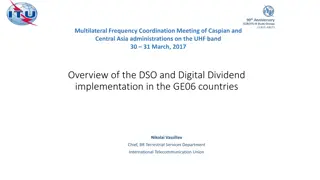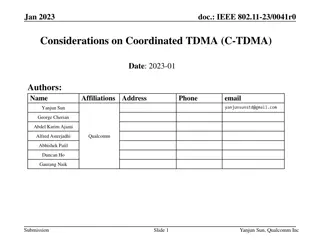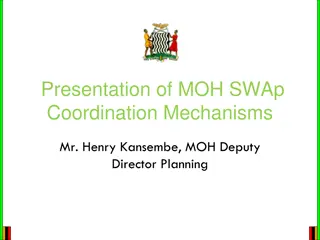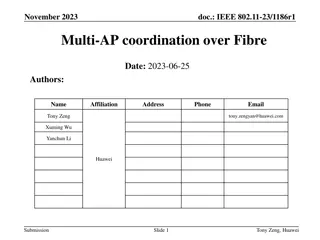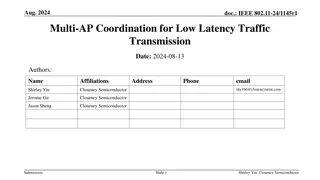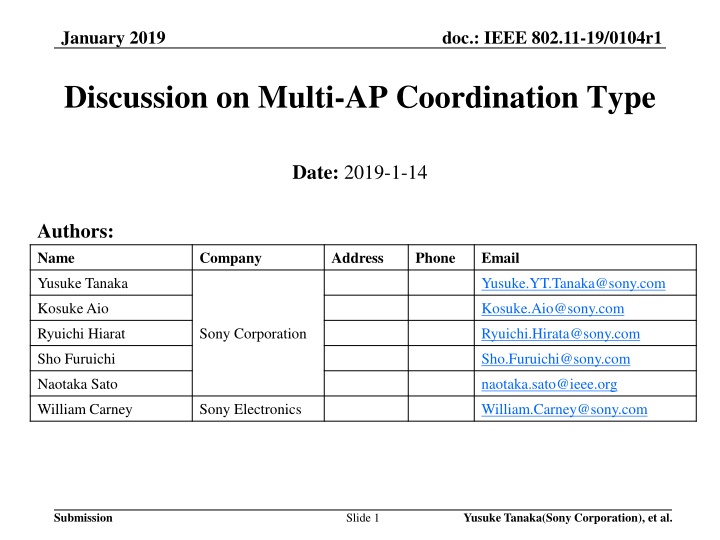
Multi-AP Coordination Types Overview
Discusses the various types of Multi-AP coordination in EHT technology, clarifying terminologies and concepts for efficient wireless network management and optimization.
Download Presentation

Please find below an Image/Link to download the presentation.
The content on the website is provided AS IS for your information and personal use only. It may not be sold, licensed, or shared on other websites without obtaining consent from the author. If you encounter any issues during the download, it is possible that the publisher has removed the file from their server.
You are allowed to download the files provided on this website for personal or commercial use, subject to the condition that they are used lawfully. All files are the property of their respective owners.
The content on the website is provided AS IS for your information and personal use only. It may not be sold, licensed, or shared on other websites without obtaining consent from the author.
E N D
Presentation Transcript
January 2019 doc.: IEEE 802.11-19/0104r1 Discussion on Multi-AP Coordination Type Date: 2019-1-14 Authors: Name Company Address Phone Email Yusuke Tanaka Yusuke.YT.Tanaka@sony.com Kosuke Aio Kosuke.Aio@sony.com Ryuichi Hiarat Sony Corporation Ryuichi.Hirata@sony.com Sho Furuichi Sho.Furuichi@sony.com Naotaka Sato naotaka.sato@ieee.org William Carney Sony Electronics William.Carney@sony.com Submission Yusuke Tanaka(Sony Corporation), et al. Slide 1
January 2019 doc.: IEEE 802.11-19/0104r1 Introduction Baseline PAR[1] and CSD[2] for EHT were created during the November IEEE 802.11 meeting. The baseline PAR includes a list of candidate features that have been discussed. The list includes Multi-AP Coordination that is one of well accepted technologies in EHT. Various types of Multi-AP coordination have been proposed and discussed in a lot of contributions. [3-16] Submission Yusuke Tanaka(Sony Corporation), et al. Slide 2
January 2019 doc.: IEEE 802.11-19/0104r1 Multi-AP Coordination Types Multi-AP coordination types have been categorized based on some aspects. E.g. Implementation complexity, MAC/PHY-level coordination. Contribution [15] clarifies Multi-AP coordination types with an appropriate terminology list. The list of terminologies would be a good baseline to discuss Multi-AP coordination technologies with avoiding confusion. The terminologies are as follows; Coordinated Beamforming Coordinated OFDMA Joint Processing Transmission Submission Yusuke Tanaka(Sony Corporation), et al. Slide 3
January 2019 doc.: IEEE 802.11-19/0104r1 Purpose of this contribution As mentioned in [15], the list of terminologies is not exhaustive and here are some types that are not captured in the list yet. 1. Enhancement of Handover and AP selection by Multi-AP coordination [13, 14] 2. Transmission scheduling by Multi-AP coordination [6, 8, 11, 14, 16] Some of contributions use terminology time/frequency coordination , but the concept of frequency coordination is captured in OFDMA coordination. Therefore here time domain scheduling is focused. The purpose of this contribution is to clarify concepts of these types of Multi-AP coordination. This contribution can be complementary with other contributions [9, 15] which have discussed Multi-AP coordination types. Submission Yusuke Tanaka(Sony Corporation), et al. Slide 4
January 2019 doc.: IEEE 802.11-19/0104r1 Enhancement of Handover and AP selection This type of Multi-AP Coordination includes; Seamless Handover This technology improve re-connection speed where users move around. (e.g. office, hotspot, home scenario) APs exchange STA info (e.g. address, capability), AP info (e.g. BSSID, BSS color) and RSSI between APs and a STA. APs make decision on which AP re-establishes connection. The AP and STA exchange fewer frames to re-establish connection. Exchange info and make decision AP1 AP2 Re-establishing connection Association STA(moving) AP1 Information exchange Optimal AP selection for association. AP selection here means that unassociated STAs select an AP for association. This technology enables fast association with an optimal AP. APs exchange AP info (e.g. BSSID, BSS color, BSS load, capability) and RSSI between APs and the STA. APs announce it in a frame (e.g. beacon) to unassociated STAs. AP2 AP3 Information of multiple APs STA(unassociated) Submission Yusuke Tanaka(Sony Corporation), et al. Slide 5
January 2019 doc.: IEEE 802.11-19/0104r1 Enhancement of Handover and AP selection Aspects of this type are; Both technologies are related to Association and Re-association. These are realized by MAC enhancement. Phy-level synchronization is not required. Multiple APs exchange information, e.g. STA address, BSSID, BSS color, capability, BSS Load, RSSI between APs and a STA. These are not data transmission, therefore these should be separately treated from technologies related to data transmission. These are similar with coordinated technique[15] from the aspects of frame exchange. Frames are transmitted between one user and one AP. This type of Multi-AP coordination can be called; Coordinated association/handover Submission Yusuke Tanaka(Sony Corporation), et al. Slide 6
January 2019 doc.: IEEE 802.11-19/0104r1 Transmission scheduling This type of Multi-AP Coordination includes; Transmission timing scheduling This technology can mitigate mutual interference among multiple APs due to autonomous behavior of conventional WLANs. APs exchange traffic info (e.g. data rate, direction, latency requirement) and AP info (e.g. capability, schedule request). APs make decision on transmission timing. APs control downlink transmission by themselves and uplink transmission by trigger-based transmission. AP1 (BSS1) AP3 (BSS3) AP2 (BSS2) Tx/Rx Tx/Rx Tx/Rx time AP1 (BSS1) AP3 (BSS3) AP2 (BSS2) Transmission timing scheduling with spatial reuse This technology can mitigate mutual interference among multiple APs and improve spectrum utilization efficiency. Multiple APs exchange spatial reuse info (e.g. parameters for transmission power control) in addition to traffic info and AP info. APs make decision on transmission timing and transmission power. Tx/Rx w/ TPC Tx/Rx Tx/Rx Tx/Rx w/ TPC Tx/Rx w/ TPC Tx/Rx time Submission Yusuke Tanaka(Sony Corporation), et al. Slide 7
January 2019 doc.: IEEE 802.11-19/0104r1 Transmission scheduling Aspects of this type are; These are expansion of 11ax trigger-based transmission and spatial reuse to Multi-AP Coordination. Multiple APs exchange information, e.g. data rate/direction/latency requirement of traffic, capability, schedule request, parameters for transmission power control. These are data transmission, therefore these should be a part of technologies related to data transmission. Data is transmitted between one user and one AP, so this is coordinated technique [15]. This type of Multi-AP coordination can be called; Coordinated timing scheduling Submission Yusuke Tanaka(Sony Corporation), et al. Slide 8
January 2019 doc.: IEEE 802.11-19/0104r1 Summary of Multi-AP Coordination Type Following Multi-AP coordination types were analyzed. Coordinated association/handover This is enhancement of Handover and AP selection for association. Coordinated timing scheduling This is transmission scheduling and enabling frequency reuse. This contribution can be complementary with other contributions [9, 15] which have discussed Multi-AP coordination types Note that this contribution has no intention to exclude any other types of Multi- AP coordination which is not captured or newly proposed in the future. Any feedbacks to brush up the analysis or naming are welcome. Submission Yusuke Tanaka(Sony Corporation), et al. Slide 9
January 2019 doc.: IEEE 802.11-19/0104r1 Considerations on the baseline PAR The current baseline PAR[1] includes Multi-AP Coordination. It reflects the situation that this technology have been actively discussed. There is description of an example of Multi-AP coordination types (e.g. coordinated and joint transmission). As discussed in this contribution, various types of Multi-AP coordination have been proposed and discussed (e.g. Coordinated OFDMA, coordinated association/handover, coordinated timing scheduling.) This contribution reconfirms that the description is just one example and any types of Multi-AP Coordination can be considered to achieve the primary objectives of EHT. Submission Yusuke Tanaka(Sony Corporation), et al. Slide 10
January 2019 doc.: IEEE 802.11-19/0104r1 Summary This contribution reviewed Multi-AP coordination types which have been proposed in EHT. This contribution clarified following types of Multi-AP coordination. Coordinated association/handover Coordinated timing scheduling Submission Yusuke Tanaka(Sony Corporation), et al. Slide 11
January 2019 doc.: IEEE 802.11-19/0104r1 Reference [1] 11-18-1231-01-0eht-eht-draft-proposed-par [2] 11-18-1233-01-0eht-eht-draft-proposed-csd [3] 11-18-1116-00-0eht-multi-ap-harq-for-eht [4] 11-18-1155-01-0eht-multi-ap-enhancement-and-multi-band-operations [5] 11-18-1161-00-0eht-eht-technology-candidate-discussions [6] 11-18-1215-01-0eht-discussion-on-par [7] 11-18-1439-00-0eht-distributed-mu-mimo [8] 11-18-1461-01-0eht-discussions-on-the-phy-features-for-eht [9] 11-18-1509-00-0eht-features-for-multi-ap-coordination [10] 11-18-1510-01-0eht-ap-coordinated-beamforming-for-eht [11] 11-18-1533-00-0eht-view-on-eht-candidate-features [12] 11-18-1547-00-0eht-technology-features-for-802-11-eht [13] 11-18-1575-00-0eht-further-study-on-potential-features [14] 11-18-1576-01-0eht-considerations-on-ap-coordination [15] 11-18-1926-02-0eht-terminology-for-ap-coordination [16] 11-19-0103-00-0eht-ap-coordination-in-eht Submission Yusuke Tanaka(Sony Corporation), et al. Slide 12

